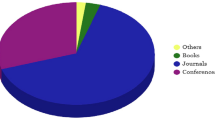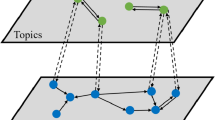Abstract
Social media needs social networks to disseminate information among the people who like to interact with each other. Identification of the most prominent influencers is a crucial problem for influence diffusion in applications like viral marketing. Most of the previous works on influence diffusion studied the topological nature of the users but ignored the effects of communities within a network. This paper proposes a new method called the TSGC method, where the whole graph is divided into different non-overlapping communities. Each of the communities is taken as a subgraph by ignoring the connecting links between them. The most influential users are identified by using each node’s local and global centrality measures in the given subgraph of a graph. Finally, the ranking of each node is performed by calculating the \(Iscore_{p}\) of each node within a whole network. Experimental results on six datasets confirm that the proposed TSGC method outperforms many well-known existing methods in terms of influence diffusion phenomenon under both the LT and IC models. This paper also proposes a new model where an active promoter may lose his influencing potential over time, go to a recovered state where he is no longer active or can activate others, and then go to a susceptible state where he is prone to getting influenced in the future. A user who is influenced by an active user can also become an active user. We termed this model the ICIRS model. This model undergoes influence diffusion in continuous time, unlike discrete-time steps as focused in most of the existing papers. Our experimental evaluations on the datasets reveal that the ICIRS model performs non-progressive influence diffusion.











Similar content being viewed by others
References
Al-Garadi MA, Varathan KD, Ravana SD et al (2018) Analysis of online social network connections for identification of influential users: survey and open research issues. ACM Comput Surveys (CSUR) 51(1):1–37. https://doi.org/10.1145/3155897
Alshahrani M, Fuxi Z, Sameh A et al (2020) Efficient algorithms based on centrality measures for identification of top-k influential users in social networks. Inf Sci 527:88–107. https://doi.org/10.1016/j.ins.2020.03.060
Banerjee S, Jenamani M, Pratihar DK (2019) Combim: a community-based solution approach for the budgeted influence maximization problem. Expert Syst Appl 125:1–13. https://doi.org/10.1016/j.eswa.2019.01.070
Borgatti SP (2006) Identifying sets of key players in a social network. Comput Math Organ Theory 12(1):21–34. https://doi.org/10.1007/s10588-006-7084-x
Borgatti SP, Everett MG, Johnson JC (2018) Analyzing social networks. Sage, London
Clauset A, Newman ME, Moore C (2004) Finding community structure in very large networks. Phys Rev E 70(6):066111. https://doi.org/10.1103/PhysRevE.70.066111
Devi K, Tripathi R (2020) Information diffusion within a limited budget using node centralities and community detection. In: 2020 21st Asia-Pacific network operations and management symposium (APNOMS), IEEE, pp 197–202, https://doi.org/10.23919/APNOMS50412.2020.9236993
Ding Q, Li W, Hu X et al (2020) The sis diffusion process in complex networks with independent spreaders. Phys A 546(122):921. https://doi.org/10.1016/j.physa.2019.122921
Dong J, Ye F, Chen W, et al (2018) Identifying influential nodes in complex networks via semi-local centrality. In: 2018 IEEE international symposium on circuits and systems (ISCAS), IEEE, pp 1–5. https://doi.org/10.1109/ISCAS.2018.8351889
Gao M, Xu L, Lin L et al (2020) Influence maximization based on activity degree in mobile social networks. Concurr Comput Pract Exp 32(11):e5677. https://doi.org/10.1002/cpe.5677
Granovetter M (1978) Threshold models of collective behavior. Am J Sociol 83(6):1420–1443
Gruhl D, Guha R, Liben-Nowell D, et al (2004) Information diffusion through blogspace. In: Proceedings of the 13th international conference on World Wide Web, pp 491–501
Jain L, Katarya R (2019) Discover opinion leader in online social network using firefly algorithm. Expert Syst Appl 122:1–15. https://doi.org/10.1016/j.eswa.2018.12.043
Jin Y, Wang W, Xiao S (2007) An sirs model with a nonlinear incidence rate. Chaos Solitons Fractals 34(5):1482–1497. https://doi.org/10.1016/j.chaos.2006.04.022
Kandhway K, Kuri J (2014) How to run a campaign: optimal control of sis and sir information epidemics. Appl Math Comput 231:79–92
Kempe D, Kleinberg J, Tardos É (2003) Maximizing the spread of influence through a social network. In: Proceedings of the ninth ACM SIGKDD international conference on Knowledge discovery and data mining, pp 137–146. https://doi.org/10.1145/956750.956769
Khomami MMD, Rezvanian A, Meybodi MR et al (2021) Cfin: a community-based algorithm for finding influential nodes in complex social networks. J Supercomput 77:2207–2236. https://doi.org/10.1007/s11227-020-03355-2
Kitsak M, Gallos LK, Havlin S et al (2010) Identification of influential spreaders in complex networks. Nat Phys 6(11):888–893. https://doi.org/10.1038/nphys1746
Kumar S, Lohia D, Pratap D et al (2021) Mder: modified degree with exclusion ratio algorithm for influence maximisation in social networks. Computing. https://doi.org/10.1007/s00607-021-00960-8
Leskovec J, Adamic LA, Huberman BA (2007) The dynamics of viral marketing. ACM Transactions on the Web (TWEB) 1(1):5–es
Li Y, Fan J, Wang Y et al (2018) Influence maximization on social graphs: a survey. IEEE Trans Knowl Data Eng 30(10):1852–1872. https://doi.org/10.1109/TKDE.2018.2807843
Liu F, Buss M (2020) Optimal control for heterogeneous node-based information epidemics over social networks. IEEE Trans Control Network Syst 7(3):1115–1126. https://doi.org/10.1109/TCNS.2019.2963488
Ma J, Fan J (2019) Local optimization for clique-based overlapping community detection in complex networks. IEEE Access 8:5091–5103. https://doi.org/10.1109/ACCESS.2019.2962751
Ma T, Liu Q, Cao J et al (2020) Lgiem: global and local node influence based community detection. Futur Gener Comput Syst 105:533–546. https://doi.org/10.1016/j.future.2019.12.022
Meghanathan N (2015) Use of eigenvector centrality to detect graph isomorphism. Comput Sci Inf Technol. https://doi.org/10.5121/csit.2015.51501
Moradi P, Rostami M (2015) Integration of graph clustering with ant colony optimization for feature selection. Knowl Based Syst 84:144–161. https://doi.org/10.1016/j.knosys.2015.04.007
More JS, Lingam C (2019) A si model for social media influencer maximization. Appl Comput Inf 15(2):102–108. https://doi.org/10.1016/j.aci.2017.11.001
Newman ME (2006) Modularity and community structure in networks. Proc Natl Acad Sci 103(23):8577–8582. https://doi.org/10.1073/pnas.0601602103
Pal SK, Kundu S, Murthy C (2014) Centrality measures, upper bound, and influence maximization in large scale directed social networks. Fund Inf 130(3):317–342. https://doi.org/10.3233/FI-2014-994
Richardson M, Domingos P (2002) Mining knowledge-sharing sites for viral marketing. In: Proceedings of the eighth ACM SIGKDD international conference on Knowledge discovery and data mining, pp 61–70. https://doi.org/10.1145/775047.775057
Saadatniaki F, Khan UA (2018) Product adoption in heterogeneous networks: An epidemiological perspective. In: 2018 52nd Asilomar Conference on Signals, Systems, and Computers, IEEE, pp 1043–1047. https://doi.org/10.1109/ACSSC.2018.8645221
Salavati C, Abdollahpouri A, Manbari Z (2018) Bridgerank: a novel fast centrality measure based on local structure of the network. Phys A 496:635–653. https://doi.org/10.1016/j.physa.2017.12.087
Shaji A, Belfin R, Kanaga EGM (2018) An innovated sirs model for information spreading. In: Advances in big data and cloud computing. Springer, p 405–413. https://doi.org/10.1007/978-981-10-7200-0_37
Sztrik J et al (2012) Basic queueing theory. University of Debrecen, Faculty of Informatics 193:60–67
Tulu MM, Hou R, Younas T (2018) Identifying influential nodes based on community structure to speed up the dissemination of information in complex network. IEEE Access 6:7390–7401. https://doi.org/10.1109/ACCESS.2018.2794324
Wang Y, Wang J, Wang H et al (2021) Users’ mobility enhances information diffusion in online social networks. Inf Sci 546:329–348. https://doi.org/10.1016/j.ins.2020.07.061
Woo J, Chen H (2016) Epidemic model for information diffusion in web forums: experiments in marketing exchange and political dialog. Springerplus 5(1):1–19. https://doi.org/10.1186/s40064-016-1675-x
Zhang L, Luo M, Boncella RJ (2020) Product information diffusion in a social network. Electron Commer Res 20(1):3–19. https://doi.org/10.1007/s10660-018-9316-9
Zhu Z (2013) Discovering the influential users oriented to viral marketing based on online social networks. Phys A 392(16):3459–3469. https://doi.org/10.1016/j.physa.2013.03.035
Author information
Authors and Affiliations
Corresponding author
Additional information
Publisher's Note
Springer Nature remains neutral with regard to jurisdictional claims in published maps and institutional affiliations.
Rights and permissions
Springer Nature or its licensor (e.g. a society or other partner) holds exclusive rights to this article under a publishing agreement with the author(s) or other rightsholder(s); author self-archiving of the accepted manuscript version of this article is solely governed by the terms of such publishing agreement and applicable law.
About this article
Cite this article
Devi, K., Tripathi, R. Identification of best social media influencers using ICIRS model. Computing 105, 1547–1569 (2023). https://doi.org/10.1007/s00607-023-01159-9
Received:
Accepted:
Published:
Issue Date:
DOI: https://doi.org/10.1007/s00607-023-01159-9




